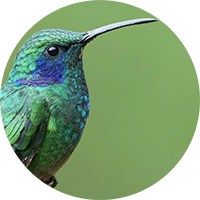Lesser Violetear
The Lesser Violetear (Colibri cyanotus) Read in Spanish
Appearance: The Lesser Violetear is distinguished by its iridescent green plumage on the upperparts and a prominent violet-blue patch behind the eye. It has a white postocular spot and a black bill with a red base. The underparts are mainly grayish-white with a green wash on the chest and sides.
Habitat: The Lesser Violetear inhabits a range of habitats, including montane forests, cloud forests, and forest edges, typically in mountainous regions. It can be found in the Andean mountain range across different elevations, where it feeds on nectar from various flowering plants.
Behavior: This hummingbird species is known for its agile flight capabilities, allowing it to hover and feed on nectar from flowers. It defends feeding territories and may interact aggressively with other birds to protect food sources.
Breeding: The breeding habits of the Lesser Violetear involve courtship displays by males, where they perform aerial acrobatics and vocalizations to attract females. The female constructs a cup-shaped nest made of plant material, which she lines with soft materials like moss and feathers.
Conservation Status: The conservation status of the Sparkling Violetear is currently categorized as "Least Concern" by the International Union for Conservation of Nature (IUCN).
Distribution
The Lesser Violetear (Colibri cyanotus) is primarily found in the mountainous regions of Colombia, particularly in the Andean mountain range.
Eastern Andes: This region includes areas such as Boyacá, Cundinamarca, and Santander departments, where the Lesser Violetear can be found in montane forests and cloud forests at different elevations.
Central Andes: In regions like Caldas, Risaralda, and Quindio departments, the Lesser Violetear may inhabit mountainous areas with lush vegetation and abundant floral resources.
Western Andes: Within departments like Antioquia and Chocó, the Lesser Violetear can be observed in the humid forests and forest edges of the western slopes of the Andes.
Southern Andes: This region includes areas in departments like Narino and Putumayo, where the Lesser Violetear may reside in the Andean foothills and upper montane forests.
Taxonomy
The Lesser Violetear (Colibri cyanotus)
- Kingdom: Animalia
- Phylum: Chordata
- Class: Aves (Birds)
- Order: Caprimulgiformes
- Family: Trochilidae
- Genus: Colibri cyanotus
- Species: Colibri cyanotus
Vocalization
The Lesser Violetear, like many hummingbird species, uses vocalizations as a form of communication for various purposes, including territorial defense, courtship, and general interactions with other individuals.
- Chirping Sounds: The Lesser Violetear often produces short, rapid chirping sounds, which can serve as communication signals within their territory or during interactions with other hummingbirds.
- Buzzing Calls: They may also emit buzzing calls, which are often rapid and slightly higher-pitched than their chirps. These buzzing sounds may vary in intensity and duration depending on the context in which they are used.
- Trills: Trilling vocalizations are another common sound made by the Lesser Violetear. These trills consist of rapid, continuous notes that can be repeated in a series, possibly used in territorial disputes or during courtship displays.
- Alarm Calls: When feeling threatened or alarmed by predators or other disturbances, the Lesser Violetear may produce sharp, high-pitched vocalizations to alert nearby individuals and signal potential danger.
- Courtship Calls: During courtship displays, male Lesser Violetears may vocalize specific sounds to attract females and establish their presence within a territory. These courtship calls can be more elaborate and distinctive compared to their everyday vocalizations.





